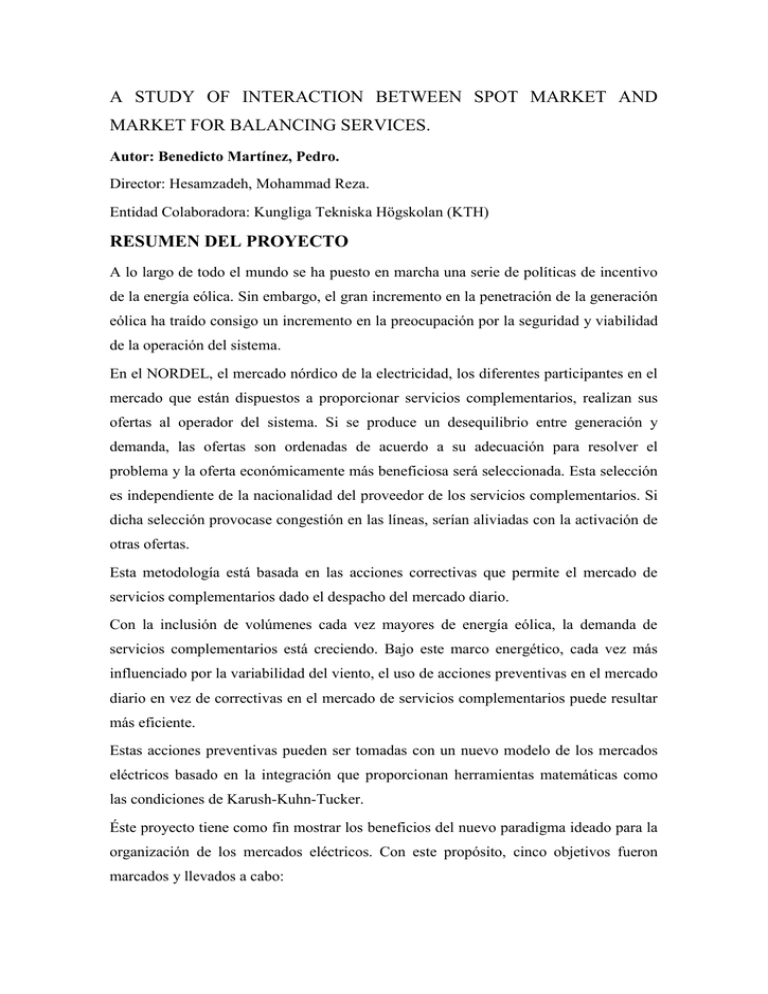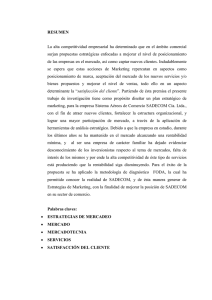a study of interaction between spot market and market for
Anuncio

A STUDY OF INTERACTION BETWEEN SPOT MARKET AND MARKET FOR BALANCING SERVICES. Autor: Benedicto Martínez, Pedro. Director: Hesamzadeh, Mohammad Reza. Entidad Colaboradora: Kungliga Tekniska Högskolan (KTH) RESUMEN DEL PROYECTO A lo largo de todo el mundo se ha puesto en marcha una serie de políticas de incentivo de la energía eólica. Sin embargo, el gran incremento en la penetración de la generación eólica ha traído consigo un incremento en la preocupación por la seguridad y viabilidad de la operación del sistema. En el NORDEL, el mercado nórdico de la electricidad, los diferentes participantes en el mercado que están dispuestos a proporcionar servicios complementarios, realizan sus ofertas al operador del sistema. Si se produce un desequilibrio entre generación y demanda, las ofertas son ordenadas de acuerdo a su adecuación para resolver el problema y la oferta económicamente más beneficiosa será seleccionada. Esta selección es independiente de la nacionalidad del proveedor de los servicios complementarios. Si dicha selección provocase congestión en las líneas, serían aliviadas con la activación de otras ofertas. Esta metodología está basada en las acciones correctivas que permite el mercado de servicios complementarios dado el despacho del mercado diario. Con la inclusión de volúmenes cada vez mayores de energía eólica, la demanda de servicios complementarios está creciendo. Bajo este marco energético, cada vez más influenciado por la variabilidad del viento, el uso de acciones preventivas en el mercado diario en vez de correctivas en el mercado de servicios complementarios puede resultar más eficiente. Estas acciones preventivas pueden ser tomadas con un nuevo modelo de los mercados eléctricos basado en la integración que proporcionan herramientas matemáticas como las condiciones de Karush-Kuhn-Tucker. Éste proyecto tiene como fin mostrar los beneficios del nuevo paradigma ideado para la organización de los mercados eléctricos. Con este propósito, cinco objetivos fueron marcados y llevados a cabo: 1. Buscar, recopilar y analizar la bibliografía relacionada con el tema. 2. Programar un modelo de flujo de cargas óptimo de CC sujeto a la minimización de los costes asociados al sistema eléctrico. Este modelo representa el funcionamiento actual del mercado eléctrico, donde los servicios complementarios son contratados para proporcionar acciones correctivas que permitan equilibrar los errores cometidos en la previsión de la demanda y la generación eólica. 3. Desarrollar un segundo modelo, orientado a acciones preventivas en vez de correctivas. Esta nueva formulación está basada en las anteriormente mencionadas condiciones de Karush-Kuhn-Tucker. Estas nuevas condiciones sustituyen a las restricciones del mercado de servicios complementarios e integran ambos estadios del proceso: el mercado diario y el mercado de servicios complementarios. 4. Ejecutar ambos modelos en el software de optimización GAMS, utilizando un sistema eléctrico cuidadosamente diseñado para analizar y comentar los resultados obtenidos en los distintos casos considerados. Este sistema incluye importantes características como generación eólica, pérdidas de potencia activa y conexiones High-Voltage Direct Current (HVDC) para comunicar parques eólicos offshore con el resto del sistema. La aleatoriedad del problema se ha tenido en cuenta haciendo uso del método de Monte Carlo. 5. Poner de relieve las ventajas que la nueva aproximación a la organización del mercado eléctrico tiene gracias a las medidas correctivas comparado con el modelo imperante en la actualidad. Los resultados son claros y muestran una drástica reducción en los costes de los servicios complementarios activados cuando se toman acciones preventivas. La reducción crece conforme la aleatoriedad del sistema se incrementa y la tendencia también se ve acentuada bajo un escenario con penetración eólica. La creciente preocupación sobre el cambio climático, políticas medio ambientales como el triple objetivo 20-20-20 de la Unión Europea, políticas que promocionan la independencia energética y el rechazo a la las plantas nucleares son algunas de las razones que explican el rápido incremento en la implantación de las energías renovables, especialmente la energía eólica. Esta tendencia se presume imparable y vendrá aparejada de un alza en los costes de los servicios complementarios. Este escenario perfila un excelente futuro para todas las tecnologías que buscan reducir estos costes. A STUDY OF INTERACTION BETWEEN SPOT MARKET AND MARKET FOR BALANCING SERVICES. Around the world, there are a number of policies encouraging penetration of wind generation in the electricity industry. The proposed large increase in the penetration of wind generation has raised concerns about the continued security and reliability of the operation of the network. In NORDEL, the Nordic common market of electricity, market participants who are willing to provide the balancing services offer their services to the Transmission System Operator, TSO. In case of any system imbalance, the offers are listed in a merit order list and the cheapest offer will be selected. This selection is regardless of balancing service provider’s nationality. If congestion happens, some other offers will be used to relieve congested line. This results in different prices for balancing services in different areas. This methodology is based on the corrective actions in the market for balancing services given the dispatch information from the spot market. With the increased penetration of wind generation into the electricity industry, the demand for balancing services is increasing. Under these windy scenarios, it might be more efficient to use preventive actions in the spot market rather than doing corrective actions in the market for balancing services. These preventive actions can be taken with a new approach to the formulation of the electricity markets based on the integration that provide mathematical tools such as the Karush-Kuhn-Tucker conditions. This master thesis aims at showing the advantages of this new paradigm of the organization of the electricity market. With this purpose, five objectives were set and accomplished: 1. Searching, collecting and analyzing the bibliography related with the topic in different scientific sources. 2. Programming a DC Optimal Power Flows (DC-OPF) model subject to the minimization of the cost associated to the electric power system. This model represents the current perform of the electricity market where balancing services are procured to provide corrective actions to balance the errors committed in the forecast of the demand and wind generation. 3. Developing a second model, with a balancing market oriented to preventive actions rather than corrective. This new formulation is based on the aforementioned Karush-Kuhn-Tucker conditions. These conditions substitute the constraints of the balancing market and integrate both steps of the process: spot market and market for balancing services. 4. Run both models in GAMS software. An electric system carefully designed in order to analyze and comment the results obtained in the different cases considered. This system includes important features like wind generation, power losses and High-Voltage Direct Current (HVDC) links that connect offshore wind farms with mainland. The stochasticity of the problem was taken into account with the help of the Monte Carlo technique. 5. Highlight the benefits that the new approach to the organization of the electricity market has thanks to the corrective measures compared to the prevailing scheme. Results are clear and show a dramatic reduction of the costs of balancing services when preventive measures are taken. The reduction grows as the stochasticity of the system is increased and the trend is augmented under a with wind generation scenario. Growing concern about climate change, environmental policies like the 20-20-20 target of the EU, policies which encourage energetic independency and rejection to nuclear power plants are some of the reasons that explain the sharp increase of the installation of renewable energies, especially wind energy. This trend seems to be unstoppable and together with it, rises in the balancing costs will come. This scenario shapes an excellent future to technologies which aim at reducing these costs.

